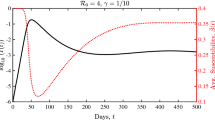Abstract
The models considered for the spread of an infectious disease in a population are of SIRS or SIS type with a standard incidence expression. The varying population size is described by a modification of the logistic differential equation which includes a term for disease-related deaths. The models have density-dependent restricted growth due to a decreasing birth rate and an increasing death rate as the population size increases towards its carrying capacity. Thresholds, equilibria and stability are determined for the systems of ordinary differential equations for each model. The persistence of the infectious disease and disease-related deaths can lead to a new equilibrium population size below the carrying capacity and can even cause the population to become extinct.
Similar content being viewed by others
References
Anderson, R. M., Jackson, H. C., May, R. M., Smith, A. D. M.: Population dynamics of fox rabies in Europe. Nature 289, 765–777 (1981)
Anderson, R. M., May, R. M.: Regulation and stability of host-parasite interactions. J. Anim. Ecol. 47, 219–247 (1978)
Anderson, R. M., May, R. M.: Population biology of infectious diseases I. Nature 180, 361–367 (1979)
Anderson, R. M., May, R. M., McLean, A. R.: Possible demographic consequences of AIDS in developing countries. Nature 332, 228–234 (1988)
Brauer, F.: Epidemic models in populations of varying size. In: Castillo-Chavez, C., Levin, S. A., Shoemaker, C. (eds.) Mathematical approaches to ecological and environmental problem solving, pp. 109–123. Berlin Heidelberg New York: Springer 1989
Brauer, F.: Models for the spread of universally fatal diseases. J. Math. Biol. 28, 451–462 (1990)
Bremermann, H. J., Thieme, H. R.: A competitive exclusion principle for pathogen virulence. J. Math. Biol. 27, 179–190 (1989)
Busenberg, S. N., van den Driessche, P.: Analysis of a disease transmission model in a population with varying size. J. Math. Biol. 28, 257–270 (1990)
Busenberg, S. N., Hadeler, K. P.: Demography and epidemics. Math. Biosci. 101, 41–62 (1990)
Castillo-Chavez, C. C., Cooke, K. L., Huang, L., Levin, S. A.: On the role of long periods of infectiousness in the dynamics of AIDS, Part 1, Single population models. J. Math. Biol. 27, 373–398 (1989)
Edelstein-Keshet, L.: Mathematical models in biology. New York: Random House 1988
Hale, J. K.: Ordinary differential equations. New York: Wiley-Interscience 1969
Hethcote, H. W.: Qualitative analysis for communicable disease models. Math. Biosci. 28, 335–356 (1976)
Hethcote, H. W.: Three basic epidemiological models. In: Gross, L., Hallam, T. G., Levin, S. A. (eds.) Applied mathematical ecology, pp. 119–144. Berlin Heidelberg New York: Springer 1989
Hethcote, H. W., Levin, S. A.: Periodicity in epidemiological models. In: Gross, L., Hallam, T. G. Levin, S. A. (eds.) Applied mathematical ecology, pp. 193–211. Berlin Heidelberg New York: Springer 1989
Hethcote, H. W., Stech, H. W., van den Driessche, P.: Periodicity and stability in epidemic models: a survey. In: Busenberg, S. N., Cooke, K. L. (eds.) Differential equations and applications in ecology, epidemic and populations problems, pp. 65–82. New York: Academic Press 1981
Hethcote, H. W., van den Driessche, P.: Some epidemiological models with nonlinear incidence. J. Math. Biol. 29, 271–287 (1991)
Hyman, J. M., Stanley, E. A.: Using mathematical models to understand the AIDS epidemic. Math. Biosci. 90, 415–473 (1988)
Jacquez, J. A., Simon, C. P., Koopman, J., Sattenspiel, L., Perry, T.: Modeling and analyzing HIV transmission: The effect of contact patterns. Math. Biosci. 92, 119–199 (1988)
Jordan, D. W., Smith, P.: Nonlinear ordinary differential equations. Oxford: Clarendon Press 1987
Liu, W. M., Hethcote, H. W., Levin, S. A.: Dynamical behavior of epidemiological models with nonlinear incidence rates. J. Math. Biol. 25, 359–380 (1987)
May, R. M., Anderson, R. M.: Regulation and stability of host-parasite population interactions. II. Destabilizing processes. J. Anim. Ecol. 47, 248–267 (1978)
May, R. M., Anderson, R. M.: Population biology of infectious diseases II. Nature 280, 455–461 (1979)
May, R. M., Anderson, R. M., McLean, A. R.: Possible demographic consequences of HIV/AIDS epidemics. Math. Biosci. 90, 475–505 (1988)
Mena-Lorca J., Hethcote, H. W.: Dynamic models of infectious diseases as regulators of population sizes. J. Math. Biol 30, 693–716 (1992)
Miller, R. K., Michel, A. N.: Ordinary differential equations. New York: Academic Press 1982
Pugliese, A.: Population models for diseases with no recovery. J. Math. Biol. 28, 65–82 (1990)
Author information
Authors and Affiliations
Additional information
Research supported in part by Centers for Disease Control contract 200-87-0515
Rights and permissions
About this article
Cite this article
Gao, L.Q., Hethcote, H.W. Disease transmission models with density-dependent demographics. J. Math. Biol. 30, 717–731 (1992). https://doi.org/10.1007/BF00173265
Received:
Revised:
Issue Date:
DOI: https://doi.org/10.1007/BF00173265




